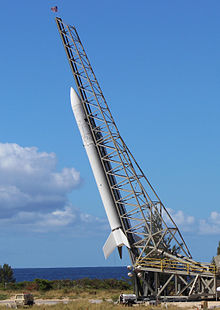 Super Strypi rocket on the launch pad | |
| Function | Expendable launch system |
|---|---|
| Manufacturer | University of Hawaii Aerojet Rocketdyne Sandia |
| Country of origin | United States |
| Size | |
| Height | 17 m (56 ft)[1] |
| Diameter | 1.5 m (4 ft 11 in) [1] |
| Mass | 28,240 kg (62,260 lb) [1] |
| Stages | Three |
| Capacity | |
| Payload to 400 km SSO | |
| Mass | 250 kilograms (550 lb) |
| Associated rockets | |
| Family | Strypi |
| Launch history | |
| Status | In development |
| Launch sites | Barking Sands |
| Total launches | 1 |
| Success(es) | 0 |
| Failure(s) | 1 |
| First flight | 3 November 2015 |
SPARK, or Spaceborne Payload Assist Rocket - Kauai, also known as Super Strypi,[2] is an American expendable launch system developed by the University of Hawaii, Sandia and Aerojet Rocketdyne.[3] Designed to place miniaturized satellites into low Earth and Sun-synchronous orbits, it is a derivative of the Strypi rocket which was developed in the 1960s in support of nuclear weapons testing. SPARK is being developed under the Low Earth Orbiting Nanosatellite Integrated Defense Autonomous System (LEONIDAS) program, funded by the Operationally Responsive Space Office of the United States Department of Defense.
- ^ a b c Graham, William (November 3, 2015). "Super Strypi conducts inaugural launch – Fails during first stage". NASA Spaceflight. Archived from the original on 2015-11-08. Retrieved 2015-11-11.
- ^ "HawaiiSat-1". eoPortal Directory. Archived from the original on 20 January 2012. Retrieved 20 January 2012.
- ^ Krebs, Gunter. "SPARK". Gunter's Space Page. Archived from the original on 15 January 2012. Retrieved 20 January 2012.